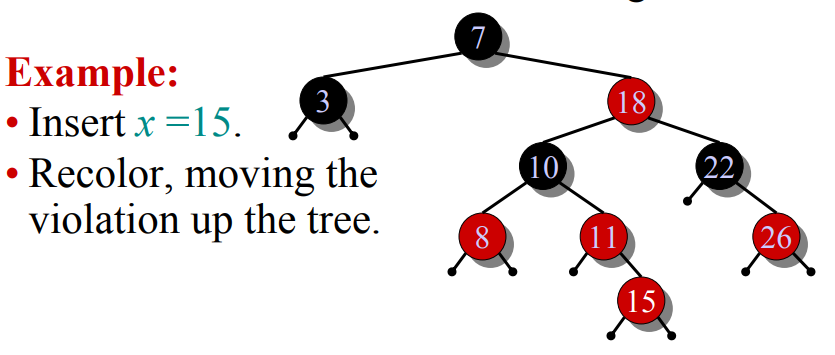Balanced Search Tree
search tree data structure maintaining dynamic set of n elements using a tree of height order lgn .
Examples
- AVL Tree
- 2-3 Tree
- 2-3-4 Tree
- B Tree
- Red-Black Trees
- Skip lists
- Treaps
Red-Black Tree
BST data structure with extra color field for each node satisfying.
Red-Black properties
- Every Node is either red or black
- the root and the leaves(nil’s) are black
- Every red node has black parent
- All simple paths from a node x to a descended leaf of x have same number of black nodes . which means have the same black-height(x)

定理 : Red-Black tree with n keys has height h <= 2lg(n+1)
证明:《算法导论》上有归纳法的详细证明
- Merge red nodes into their black parents.
- This process produce a tree in which each node has 2,3 or 4 children
- the 2-3-4 tree has uniform depth h’ of leaves
- We have
, since at most half the leaves on any path are red
- The number of leaves in each tree is n+1
Corollary . The queries Search, Min, Max, Successor, and Predecessor all run in O(lgn) time on a red-black tree with n nodes.
Modifying operations
The operations Insert and Delete cause modifications to the red-black tree:
- the operation itself,
- color changes,
restucturing the links of the tree via rotations
Rotations

A rotation can be performed in O(1) time.Insertion into a red-black tree
IDEA : Insert x in tree. Color x red. Only red-black property 3 might be violated. Move the violation up the tree by recoloring until it can be fixed with rotations and recolored.

RB-INSERT(T,x)Tree-INSERT(T,x)color[x]=redwhile x!=root[T] and color[p[x]]=REDdo if p[x]=left[p[p[x]]]then y=right[p[p[x]]]if color[y]=REDthen <Case 1>else if x=right[p[x]]then <case 2><Case 3>else<"Then" clause with "left" and "right" swapped>color[root[T]]=black



AnalysisGo up the tree performing Case 1, with only recolors node.
- If Case 2 or Case 3 occurs, perform 1 or 2 rotations, and terminate.
Running Time
O(lgn) with O(1) rotations.
RB-Delete: same asymptotic running time and number of rotations as RB-Insert(See textbook).

